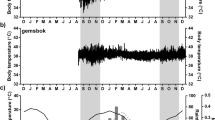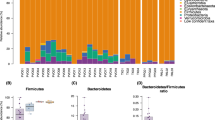Abstract
MAMMALS inhabiting desert regions might be expected to have similar physiology, particularly in rates of water use. Groups of ungulates in the field, however, show a wide range of water consumption. We measured, over periods of weeks, the uninhibited intake of water and food by groups of animals grazing together on the same territory and this was integrated with metabolic water from oxidation of hydrogen. Using this approach1 we found that buffalo (Bos bubalus bubalis) have the highest water turnover of any unstressed animal so far measured—200 ml./kg/24 h. Bos taurus in the same tropical climate were next in rank order, then Bibos banteng and the least water-demanding of the cattle group were Bos indicus (123 ml./kg/24 h). In the summer deserts of Australia and northern Kenya, the highest water turnover rates occurred in cattle, with sheep at about half their rate, goats somewhat less and camels (Camelus dromedarius) least in their water requirements, at half to one-third the rate of cattle2. In temperate environments the same rank order of genera and species was sustained. Because of different degrees of fatness (body solids, Table 1) it is useful to rank the animals by mol/l.0.82, which relates to the number of molecules passing through the size-adjusted volumes of body water.
This is a preview of subscription content, access via your institution
Access options
Subscribe to this journal
Receive 51 print issues and online access
$199.00 per year
only $3.90 per issue
Buy this article
- Purchase on Springer Link
- Instant access to full article PDF
Prices may be subject to local taxes which are calculated during checkout
Similar content being viewed by others
References
Siebert, B. D., and Macfarlane, W. V., Austral. J. Agric. Res., 20, 613 (1969).
Macfarlane, W. V., Handbook of Physiology (Amer. Physiological Society, Washington), 4, 509 (1964).
Macfarlane, W. V., in Adaptation of Domestic Animals (edit. by Hafez, E. S. E.), 272 (Lea and Febiger, Philadelphia, 1969).
Kennedy, P., and Macfarlane, W. V., Comp. Biochem. Physiol. (in the press).
Blaxter, K. L., The Energy Metabolism of Ruminants (Hutchinson, London, 1962).
Schmidt-Nielsen, K., Crawford, E. C., Newsome, A. E., Rawson, K. S., and Hammel, H. T., Amer. J. Physiol., 212, 341 (1967).
McEwen, E. H., and Whitehead, P. E., Canad. J. Zool., 48, 391, (1971).
Lasiewski, R. C., and Dawson, W. R., Condor, 69, 13 (1967).
Dawson, W. R., and Bartholomew, G. A., in Desert Biology (edit. by Brown, G. W.), 1, 357 (Academic Press, New York, 1968).
Martin, P. S., Bioscience, 20, 218 (1970).
Zeuner, F. E., A History of Domesticated Animals (Hutchinson, London, 1963).
Author information
Authors and Affiliations
Rights and permissions
About this article
Cite this article
MACFARLANE, W., HOWARD, B., HAINES, H. et al. Hierarchy of Water and Energy Turnover of Desert Mammals. Nature 234, 483–484 (1971). https://doi.org/10.1038/234483a0
Received:
Issue Date:
DOI: https://doi.org/10.1038/234483a0
This article is cited by
-
Factors influencing water intake in dairy cows: a review
International Journal of Biometeorology (2021)
-
Remarkable muscles, remarkable locomotion in desert-dwelling wildebeest
Nature (2018)
-
Oxygen consumption and body temperature in yellow-bellied marmot populations from montane-mesic and lowland-xeric environments
Journal of Comparative Physiology B (1990)
-
Adaptive energy metabolism in four chromosomal species of subterranean mole rats
Oecologia (1988)
-
The effect of a high fibre diet on energy and water balance in two Namib desert rodents
Journal of Comparative Physiology B (1985)
Comments
By submitting a comment you agree to abide by our Terms and Community Guidelines. If you find something abusive or that does not comply with our terms or guidelines please flag it as inappropriate.



